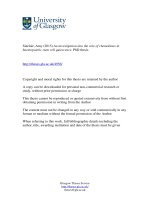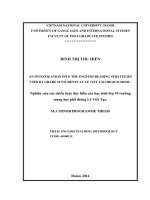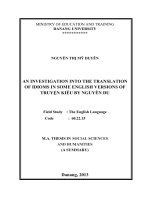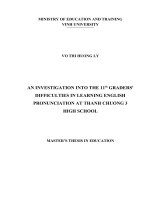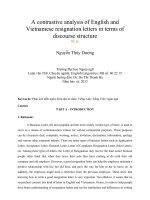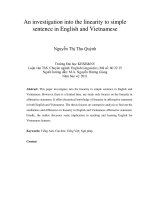An investigation into the English language used on Facebook social network by Vietnamese learners of English
Bạn đang xem bản rút gọn của tài liệu. Xem và tải ngay bản đầy đủ của tài liệu tại đây (114.88 KB, 6 trang )
A contrastive analysis of English and
Vietnamese resignation letters in terms of
discourse structure
51 p.
Nguyễn Thùy Dương
Trường Đại học Ngoại ngữ
Luận văn ThS. Chuyên ngành: English Linguistics; Mã số: 60 22 15
Người hướng dẫn: Dr. Do Thi Thanh Ha
Năm bảo vệ: 2013
Keywords: Phân tích diễn ngôn; Đơn thư từ chức; Tiếng Anh; Tiếng Việt; Ngôn ngữ
Content
PART A – INTRODUCTION
1. Rationale:
A Business Letter, the most popular and the most widely written type of letter, is used to
serve as a means of communication written for various commercial purposes. These purposes
can be a business deal, complaint, warning, notice, invitation, declaration, information, apology
and various other corporate matters. There are many types of business letters such as Application
Letter, Acceptance Letter, Demand Letter, Letter of Complaint, Resignation Letter, Sales Letters,
etc. Among these types of letters, the Letter of Resignation may receive the least notice because
people often think that when they leave their jobs they have nothing to do with their old
company and old employer. However, a good resignation letter can help the employee maintain a
positive relationship with his/ her old boss, and pave the way for him or her to move on. In
addition, the employee might need a reference from the previous employer. These show that
knowing how to write a good resignation letter is very important. Nevertheless, it seems that no
researchers concern this kind of letter in English and Vietnamese. Hence, in order to help people
have better understanding of resignation letters and see the similarities and differences in writing
style of English and Vietnamese resignation letters, this study focuses on comparing and
contrasting discourse structure of English and Vietnamese resignation letters.
2. Aims of the Study:
The aims of the study are:
− To review the background knowledge of discourse analysis and resignation letters.
− To point out the similarities and differences between discourse structures of English and
Vietnamese resignation letters.
− To give some suggestions for writing resignation letters in English and Vietnamese.
3. Scope of the Study:
Conducting this study, I do not have the ambition to cover everything about discourse
analysis of English and Vietnamese resignation letters. I only concentrate on analyzing English
and Vietnamese resignation letters in terms of discourse structures
4. Research Question:
What are the similarities and differences between discourse structures of English and
Vietnamese resignation letters?
5. Methodology of the Study:
‘Move analysis’ approach is applied in this research to analyze the discourse structure of
resignation letters in English and Vietnamese. Besides, in order to find out the similarities and
differences between discourse structure of English and Vietnamese resignation letters, the author
uses comparison and contrast method.
6. Organization of the Thesis: the study is divided into five main parts as follows:
Part A – Introduction
This part consists of rationale for choosing the topic, aims and scope of the study,
research question, research methodology, and organization of the study.
Part B – Development
Chapter 1 – Literature Review and Theoretical Background
This chapter includes general description of discourse analysis, discourse structure,
‘Move analysis’, and general information about English and Vietnamese resignation letters.
Chapter 2 – Methodology
This chapter describes the participants and methods which are applied to collect and
analyze the data.
Chapter 3 – Analysis of Discourse Structure in English and Vietnamese Resignation Letters
In this chapter, the author analyzes discourse structures in English and Vietnamese
resignation letters in detail.
Chapter 4 – Comparing and Contrasting Discourse Structure of English and Vietnamese
Resignation Letters
The similarities and differences between English and Vietnamese resignation letters in
terms of discourse structures are pointed out in this chapter.
Part C – Conclusion
In this part, the author gives some recommendations for writing a good resignation
letters, points out some limitations of the study, and gives suggestions for further study.
References
Appendixes
REFERENCES
Vietnamese:
1. Diệp Quang Ban. (1999), Văn bản và liên kết trong tiếng Việt, NXB GD, Hà Nội.
2. Nguyễn Hòa. (2003), Phân tích diễn ngôn: Một số vấn đề lý luận và phương pháp. NXB Đại
học Quốc gia Hà Nội, Hà Nội.
3. Trần Ngọc Thêm. (1985), Hệ thống liên kết văn bản tiếng Việt, NXB ĐH và THCN, Hà Nội.
English:
1. Austin, J. H. (1962), How to Do Things with Words, Oxford: Oxford University Press.
2. Bhatia, V. (1993), Analyzing genre: Language use in professional settings, London: Longman.
3. Biber, D., Connor, U. and Upton, T. (2007), Discourse on the Move: Using Corpus Analysis
to Describe Discourse Structure, Amsterdam: John Benjamins.
4. Brett, P. (1994), “A genre analysis of the results section of sociology articles”, English for
Specific Purposes, 13(1), 47–59.
5. Brown, G. and Yule, G. (1983), Discourse Analysis, Cambridge: Cambridge University Press.
6. Brown, R. (2004), “Self-composed: rhetoric in psychology personal statements”, Written
Communication, 21(3), 242–260.
7. Cook, G. (1989), Discourse, Oxford: Oxford University Press.
8. Crystal, D. (1992), Introducing Linguistics, London: Penguin
9. Ding, H. (2007), “Genre analysis of personal statements: Analysis of moves in application
essays to medical and dental schools”, English for Specific Purposes, 26 (3), 368-392.
10. Duszak, A. (1994), “Academic discourse and intellectual style”, Journal of Pragmatics,
21(3), 291-313.
11. Halliday, M. A. K. and R. Hasan. (1976), Cohesion in English, London: Longman.
12. Harris, Zellig S. (1952), “Discourse Analysis”, Language, 28 (1),1-30.
13. Holmes, R. (1997), “Genre analysis and social sciences: an investigation of the structure of
research article discussion sections in three disciplines”, English for Specific Purposes,
16(4), 321-337.
14. Hyland, K. (2003), “Graduates’ gratitude: the generic structure of dissertation
acknowledgements”, English for Specific Purposes, 22(3), 303–324.
15. Hatim, Basil & Ian Mason. (1990), Discourse and the Translator, London: Longman.
16. Nunan, D. (1993), Introducing Discourse Analysis, London: Penguin
17. Nwogu, K. N. (1991), “Discourse variation in medical texts: Schema, theme and cohesion in
professional and journalistic accounts”, Monographs in Systemic Linguistics, Vol. 2.
Nottingham: Department of English Studies, University of Nottingham.
18. Ross, R.N. (1975), “Ellipsis and the structure of expectation”, San Jose State Occasional
Papers in Linguistics1, 183-191.
19. Santos, M. F. A. (2006), “Economy, Business & Finance”, The Philippine Daily Inquirer,
June 5
th
, B2-1.
20. Schiffrin, D., Tannen, D. and Hamilton, H. (eds). (2001), The Handbook of Discourse
Analysis, Oxford: Blackwell.
21. Swales, J. (1981), Aspects of Article Introductions, Birmingham: University of Aston.
22. Swales, J. (1990), Genre Analysis: English for Academic and Research Settings, Cambridge:
Cambridge University Press.
23. Widdowson, H. G. (1979), Pragmatics, Oxford: Oxford University Press.
24. Widdowson, H. G. (1984), Exploration in Applied Linguistics, Oxford: Oxford University
Press.
Websites:
1.
2. />3.
4. />5. />

